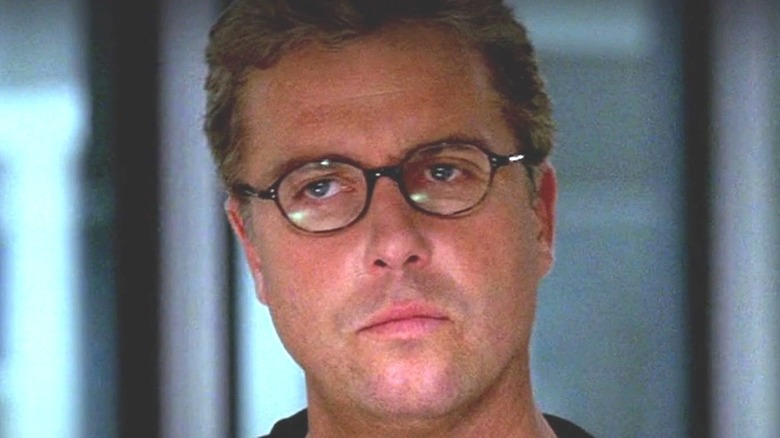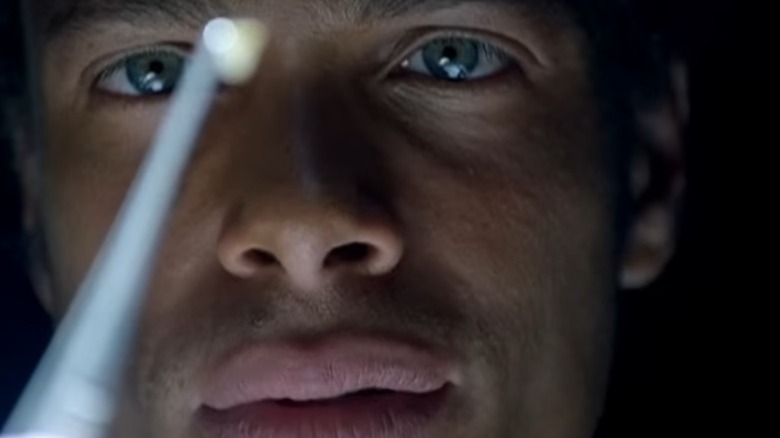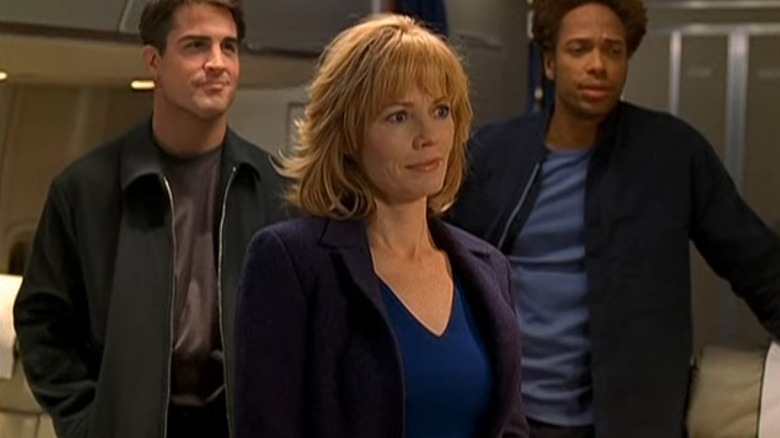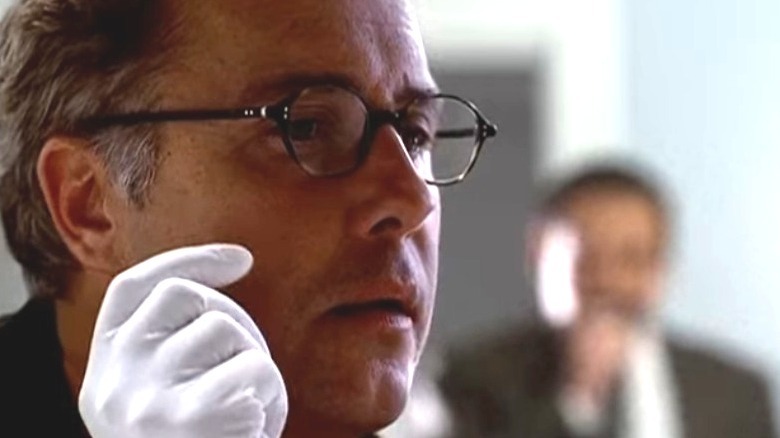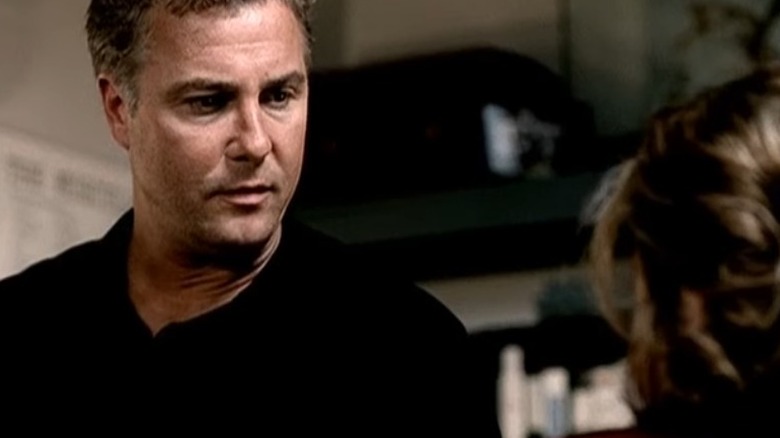Things You Only Notice When You Rewatch CSI Season 1
Although it has had multiple successful spin-offs, longtime "CSI: Crime Scene Investigation" fans heralded the return of the main series in 2021, this time under the title "CSI: Vegas." Looking back at the history of "CSI," there's no denying that the series has produced an impressive run — one that few other shows could equal. It all began in 2000, as the procedural crime drama introduced us to Gil Grissom (William Petersen) and his crime science team. Right from the beginning, the first season immediately starts running with its assortment of intriguing and bizarre crimes.
For example, Season 1 features the shocking death of a member of Grissom's team, the introduction of a possible serial killer, the discovery of a skeleton under someone's home, and a grizzly crime involving a family that leads to easily one of the season's creepiest scenes. Season 1 makes an impactful first impression, and it's packed with details we can't ignore during the first watch. But what happens when we revisit the first season decades later? It turns out that there are some unique things you can't help but notice when rewatching "CSI" Season 1.
CSI had a real impact on actual criminal investigations
To say that "CSI" made an impact on the world of television is a huge understatement. Keep in mind that we're talking about a series that served as a consistent ratings hit for CBS even in its first season. For instance, Season 1's highest-rated episode managed to earn approximately 20.8 million viewers (via Zap2it). So, with that many eyeballs on the procedural crime drama during its first proper outing, it was perhaps bound to have some massive real-world effects. But there's one particular impact we can't help but think about in retrospect when rewatching Season 1.
Even from the start, "CSI" opens up its lab coat to give us an inside look into forensic science, primarily through seeing the team out in the field taking pictures of victims or in the laboratory investigating any DNA evidence. Whether it's 100% accurate is debatable, but that didn't stop the start of the "CSI effect." The surprising ripple from "CSI" raised the expectation of jurors for forensic evidence in actual investigations. In reality, unlike the TV time-skip magic in "CSI," the quest for forensic evidence can take up to years. It's a little hard now to shake this revelation.
Even as early as Season 1, the series was inspired by headline news
Setting "CSI" in Las Vegas gives it free rein to provide some of the most memorable scenes and episode plots. After all, Las Vegas is often romanticized in media as a wild adult playground that, at all times, aims to live up to its famous Sin City moniker. Yet, "CSI" is still a procedural crime show, and like its peers such as "Law & Order," it is not above pulling inspiration from real-life news headlines, because reality is often more disturbing than fiction. During Season 1, "CSI" may most famously do this through the episode "Unfriendly Skies."
In the episode, the team investigates the death of a first-class passenger on a flight to Las Vegas. The team discovers that after the victim experiences a panic attack that leads to him trying to open the cockpit and plane exit, some of the other passengers kill him while trying to subdue him. The episode's plot is significantly similar to an actual incident that occurred roughly a few months before the debut of "CSI." Per the New York Times, on a Southwest Airlines flight from Las Vegas to Salt Lake City, Utah, passengers tragically killed a 19-year-old while trying to subdue him. Much like the victim in the show, he also seemed to have frantically tried to open the plane's cockpit. It's never been officially stated if the show based the episode on the actual incident. However, the parallels seem too alike to be a coincidence.
It increased the on-screen body count
It probably goes without saying, but 'CSI" features many scenes with dead bodies. We know that this is the gross bread and butter of a show that often deals with autopsies and the freshly deceased down at a crime scene. Today, with the number of spin-offs, reboots, and other series inspired by "CSI," these kinds of disturbing scenes are kind of the norm for primetime TV. Sure, again, there was previously "Law & Order," but it's arguable that "CSI" vastly increased the body count on network TV, especially during its first season. Revisiting Season 1, we're almost guaranteed a morgue scene every episode. Surprisingly, these scenes involving deceased victims created excellent job opportunities for many actors.
As an NPR story once noted, beginning with "CSI," Hollywood experienced a boom of casting roles for, well, dead bodies. This doesn't mean that "CSI" didn't use dummy mannequins as well, as in Season 1, we often see mannequins used in neat experiments from Grissom, such as when he replicates a body falling from the top of a casino in the episode "Cool Change." But Season 1 introduces us to one big reason why the series prefers actors for its autopsies. Usually, each episode includes a flashback of the victim before they die. So, for realism, the series needs to have that same actor lying as still as possible, covered in makeup and fake blood. In retrospect, it's cool to witness this boom in guest roles begin here.
The criminalists in CSI weren't real-life accurate
Season 1 of "CSI" sets the stage for a series that aims for as much realism as possible. After all, we're getting a detailed look into the forensic side of investigations that other procedural dramas before it hadn't quite fully explored. While "CSI" opens a floodgate into the world of crime science, there's so much that it also gets wrong about forensics. This is more evident throughout the first season, as we see our criminalists involved in investigations as if they're all also officially detectives. At the time, we all took this as meaning that criminalists are all detectives in real life, getting further involved in cases beyond the lab. Fans didn't know any better, because "CSI" is the first show of its kind.
In retrospect, when revisiting Season 1, it's easier to see the blurred line between fiction and reality, especially when it concerns the role of our crime scene investigators. According to the California Association of Criminalists, the role of a criminalist is to use the scientific method on evidence from a case and then testify the findings in court. That's it, as far as their actions in an investigation are concerned. The fact that "CSI: Crime Scene Investigation" largely ignores this for not only its first season but for much of its entire duration is a pretty big mistake. However, it is also not as if the series is the only procedural crime drama to ignore reality for the sake of gripping television.
